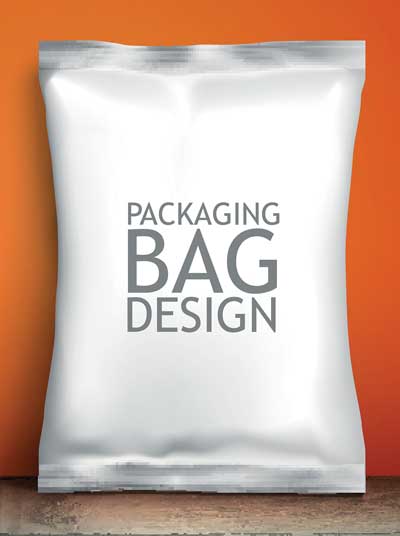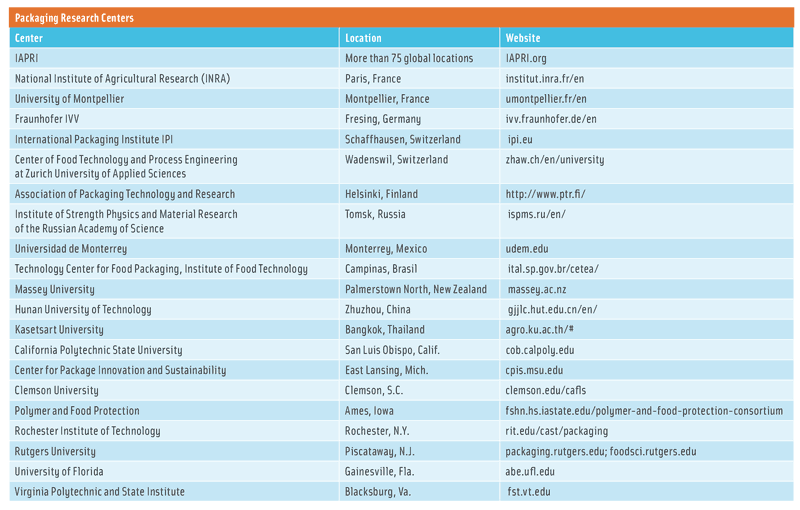Food Packaging Research: A Global Effort
PACKAGING
 Through the increase in global centers, universities, and consortia, packaging research is expanding to optimize scientific resources and meet the changing needs of the food and packaging industries. The challenges that food packaging research faces vary by country and region, but they include central goals such as reducing food waste, increasing shelf life, and enhancing sustainability. A lack of relevant food packaging research is also an issue. For example, research on bio-derived barriers is often funded by organizations that require that a specific material be investigated instead of materials that more closely address central goals. This has resulted in the repetition of development processes and the assessment of bio-barriers with limited pragmatic use. While there is a certain value in repeatedly demonstrating a concept such as bio-barrier formation, conducting relevant research requires a more comprehensive research approach. Strategies for advancing food packaging research efforts in a more comprehensive manner include networking, university-based consortia, and conferences.
Through the increase in global centers, universities, and consortia, packaging research is expanding to optimize scientific resources and meet the changing needs of the food and packaging industries. The challenges that food packaging research faces vary by country and region, but they include central goals such as reducing food waste, increasing shelf life, and enhancing sustainability. A lack of relevant food packaging research is also an issue. For example, research on bio-derived barriers is often funded by organizations that require that a specific material be investigated instead of materials that more closely address central goals. This has resulted in the repetition of development processes and the assessment of bio-barriers with limited pragmatic use. While there is a certain value in repeatedly demonstrating a concept such as bio-barrier formation, conducting relevant research requires a more comprehensive research approach. Strategies for advancing food packaging research efforts in a more comprehensive manner include networking, university-based consortia, and conferences.
Networking
A network approach involving numerous value chain partners has been used with success at numerous global institutes. Perhaps best epitomizing a network approach is the powerful NextGenPack alliance between the INRA – Montpellier Center and the Fraunhofer Institute for Process Engineering and Packaging IVV. This alliance unites transdisciplinary scientists who can refine active, intelligent, and sustainable food packaging solutions. At the laboratory of Nathalie Gontard, research director at the INRA – Montpellier Center, an early alliance between seven research institutions and two manufacturers of convenience foods has borne fruit. Gontard increased the shelf life of fresh produce by exploiting food byproducts to create wheat-gluten films that employ a high dependency of relative humidity on carbon dioxide and oxygen permeation. Wheat-gluten films can produce modified atmosphere packaging with a favorable atmosphere that can extend product shelf life better than oil-derived polymers. This research was funded by the European Commission and the National French Research Agency. When speaking about the challenges in food packaging, Gontard says, “Our main challenge is to significantly contribute to a zero-waste society by developing eco-efficient biodegradable agro-waste-based packaging materials to reduce food waste. This improves food quality and safety preservation during storage and transport while presenting a reduced environmental impact of the packaging material. Such research requires real transdisciplinary and integrated approaches including social science as well as a robust international level of collaborations between academia and the food packaging industry.”
Established in 1941, the Fraunhofer Institute for Process Engineering and Packaging IVV focuses on food packaging and is supported by more than 140 industrial members that promote research and application-oriented development with six major universities in Europe. With a goal of building a database and simulating various packaging materials and their perm-selective properties, the Fraunhofer IVV is expanding relationships to include other organizations in Germany, Poland, and Belgium. Edible film as a coating for cut produce is also being refined by Fraunhofer IVV in conjunction with the West Pomeranian University of Technology in Poland. Major initiatives to design packaging that meets the needs of innovative processing technologies are also underway. For example, Ali Abas Wani, a scientist at Fraunhofer IVV, is working on the microencapsulation of bioactive compounds under high pressure homogenization to increase their stability during different processing and storage conditions.
Other institutes have also moved food packaging research forward. The Packaging Technology Center (CETEA) within the Food Technology Institute, Brazil, is the site of the International Association of Packaging Research Institutes’ 2016 conference. Created in 1982, the CETEA now provides research assistance to more than 150 companies. The Institute of Strength Physics and Material Research of the Siberian Branch of the Russian Academy of Sciences focuses on cutting-edge research in material science and commercialization to meet the needs of food packaging. The International Packaging Institute is a center for research in Schaffhausen, Switzerland, and in Canada, PAC is an industry-directed consortium that pinpoints and acts upon common areas of concern.
University-Based Consortia
Universities are teaming up in consortia to address specific food packaging issues more effectively. In 2010 Selçuk Yildirim, a professor at the Zurich University of Applied Sciences, started a center for food technology and process engineering within the university. The center focuses on increasing food quality and shelf life with tangible packaging research. Yildirim says that the center’s success is due in part to its ability to enable commercialization: “For example, in-depth antimicrobial film commercialization requires expertise in microbiology, polymer science, food science, converting, [and] regulatory that a single researcher does not have, and we connect this expertise from the research institutes as well as from the industry,” he says. The program has biannual meetings of a Swiss Packaging Innovation Network to connect industry partners and fuel discussion for more than 25 industry partners. Approximately 90% of the center’s projects involve collaboration with industry. Since 1971, the European Cooperation in Science and Technology has provided a platform for diverse expertise to convene, share ideas, and fund research for a common concern such as shelf life. Yildirim leads the European Cooperation in Science and Technology’s working group for development and innovation to define the most viable technologies in active and intelligent packaging and technological challenges for market introduction. And new palladium-based oxygen scavengers, developed at the Zurich University of Applied Sciences, offer considerable commercialization opportunities.
Other examples of successful university consortia include the Center for Package Innovation and Sustainability at Michigan State University’s School of Packaging; this collaboration has a host of partners and members fueling a variety of research. Since the center’s inception in 2010, more than 13 multidisciplinary research projects have been funded with $1.6 million. Laura Bix, associate professor at Michigan State, and Javier de la Fuente, assistant professor at California Polytechnic State University, have demonstrated that detailed design makes all the difference, and their models to refine tabs and seal geometry to open a package while maintaining seal integrity are highly applicable to the challenges of food packaging. Kasetsart University, the first institution in Asia to offer a bachelor’s degree in packaging technology, now conducts graduate-level research in bioactive compounds, nanotechnology, and active packaging.

Clemson University has industry-sponsored laboratories that relate to food packaging. Massey University (a member of FoodHQ, a food and beverage gateway for more than 2,200 scientists around the world) is researching solutions for packaging of exported foods, with the aid of a $5 million grant. Iowa State’s Polymer and Food Protection consortium has 13 industry partners and focuses on validating the safety, functionality, and performance of recycled, sustainable, and alternative packaging. Kit Yam, director of the food packaging program at Rutgers University, concentrates on active and intelligent packaging. Bruce Welt, a professor at the University of Florida, collaborates with graduate student Ayse Demirbas to investigate ways to reduce food waste and an anthocyanin-based biosensor that detects spoilage in fish. And the new ASTM F3136-15 for dynamic permeation measurements developed by Welt and Ayman Abdellatief, a post-doctoral researcher at the University of Florida, offers an alternative to steady-state oxygen permeation testing. At the ABRE Center for Innovation in the Design of Packaging at the University of Monterrey in Mexico, package testing and innovative package development are funded by both industry and the government. Cristina Guzmán Siller, an associate professor at the University of Monterrey, is working on global packaging solutions for multinational companies doing business in Mexico.
Conferences
Conferences can inspire ideas, innovation, and research. The annual conference of the International Association of Packaging Research Institute “is an excellent platform to share knowledge to focus on a central issue of expertise,” says Guzmán Siller. For example, a working group at the 2014 conference facilitated the initial gathering of 10 scientists from nine countries to explore the millennial generation’s interest in sustainable packaging. The potential for future combined research is high within the conference’s five permanent working groups and 75 centers. And IFT’s Food Packaging Division is sponsoring four symposia at the IFT16 show on topics ranging from packaging that facilitates new processing technologies to intelligent packaging.
Finally, a number of publications showcase global food packaging research. Food Packaging and Shelf Life made its debut in 2014. It joins Packaging Technology and Science, LWT– Food Science and Technology, the Journal of Food Science, and the Journal of Food Engineering in providing excellent resources for food packaging research.
 Claire Koelsch Sand, PhD, Contributing Editor
Claire Koelsch Sand, PhD, Contributing Editor
President, Packaging Technology and Research
Adjunct Professor, Michigan State Univ.
[email protected]
